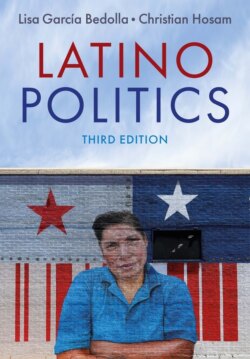Читать книгу Latino Politics - Lisa García Bedolla - Страница 21
Notes
Оглавление1 1. It must be noted that the selection of two Latinas for this performance needs to be situated within the fraught context of racial politics within the National Football League, which has been strongly criticized for its retaliation against quarterback Colin Kapernick in response to his refusal, as a player, to stand during the national anthem, in protest at state violence against African Americans and in support of the Movement for Black Lives. Despite his success in the league, no NFL team has been willing to sign Kapernick since the protests.
2 2. Alex Seitz-Wald, “Actually, Salsa Dethroned Ketchup 20 Years Ago,” The Atlantic (2013), www.theatlantic.com/national/archive/2013/10/actually-salsa-dethroned-ketchup-20-years-ago/309844.
3 3. Ibid.
4 4. Gary Trust, “Luis Fonsi, Daddy Yankee & Justin Bieber’s ‘Despacito’ Ties for Longest Run at No. 1 in Hot 100’s History,” Billboard (2017), wwwbillboard. com/articles/columns/chart-beat/7942306/despacito-hot-100-number-one-ties-record-luis-fonsi-daddy-yankee-justin-bieber.
5 5. Gary Trust, “Cardi B Becomes First Female Rapper with Two Billboard Hot 100 No. 1s, as ‘I Like It’, with Bad Bunny & J Balvin, Follows ‘Bodak Yellow’ to the Top,” Billboard (2018), www.billboard.com/articles/columns/chart-beat/8463605/cardi-b-i-like-it-hot-100-number-one-j-balvin-bad-bunny.
6 6. Julio Ricardo Varela, “Trump’s Anti-immigrant ‘Invasion’ Rhetoric Was Echoed by the El Paso Shooter for a Reason,” NBCnews.com (2019), www.nbcnews.com/think/opinion/trump-s-anti-immigrant-invasion-rhetoric-was-echoed-el-paso-ncna1039286.
7 7. Merriam Webster’s Collegiate Dictionary, 11th edn. (Springfield, MA: Merriam-Webster Inc., 2003).
8 8. Thus, individuals from Haiti, for example, or Brazil, would not be included in the definition of “Latino” used in this book.
9 9. Cristina Mora, Making Hispanics: How Activists, Bureaucrats, and Media Constructed a New America (University of Chicago Press, 2014).
10 10. Nicolas DeGenova and Ana Y. Ramos-Zayas, “Latino Racial Formations in the United States: An Introduction,” Journal of Latin American Anthropology 8 (2003): 2–16, p. 4.
11 11. Berkeley IGS Poll, February 2020.
12 12. Iris Marion Young, “Structure, Difference, and Hispanic/Latino Claims of Justice,” in Jorge J. E. Gracia and Pablo de Greiff, eds., Hispanics/Latinos in the United States: Ethnicity, Race, and Rights (New York: Routledge, 2000), 147–65, p. 153.
13 13. Omi and Winant, Racial Formation in the United States from the 1960s to the 1990s (New York: Routledge, 1994).
14 14. Linda Alcoff, “Is Latina/o Identity a Racial Identity?” in Jorge J. E. Gracia and Pablo de Greiff, eds., Hispanics/Latinos in the United States: Ethnicity, Race, and Rights (New York: Routledge, 2000), p. 246.
15 15. For an overview of whiteness, law, and the prerequisite cases, see Ian Haney-López, White by Law: The Legal Construction of Race (New York University Press, 1997).
16 16. New Orleans did have a racial system which included quadroons and other categories of mulatto, but this was the exception rather than the rule.
17 17. George Lipsitz, The Possessive Investment in Whiteness: How White People Profit from Identity Politics (Philadelphia, PA: Temple University Press, 1998).
18 18. See Dalton Conley, Being Black, Living in the Red: Race, Wealth, and Social Policy in America (Berkeley: University of California Press, 1999).
19 19. We appreciate that gender is not a binary category and that studies talking about “male” and “female” include individuals who are non-binary or hold other types of gender identifications. Unfortunately, since most studies use the binary frame, it is difficult to include the perspectives of those individuals. Thus, although we use those static categories in the text, we appreciate that gender expression is much more fluid than what is represented here.
20 20. For a summary of gender and migration trends in the United States, see Richard Fry, Gender and Migration (Washington, DC: Pew Hispanic Center, 2006), www.pewresearch.org/2006/07/06/gender-and-migration.
21 21. For an overview of these findings, see Cecilia Menjívar and Olivia Salcido, “Gendered Paths to Legal Status: The Case of Latin American Immigrants in Phoenix, Arizona” (Washington, DC: Immigration Policy Center, 2013), www.americanimmigrationcouncil.org/research/gendered-paths-legal-status-case-latin-american-immigrants-phoenix-arizona.
22 22. See Pat Zavella, I’m Neither Here Nor There: Mexican Migrants’ Quotidian Struggles with Migration and Poverty (Raleigh, NC: Duke University Press, 2011), and Jacqueline Maria Hagan, “Social Networks, Gender, and Immigrant Incorporation: Resources and Constraints,” American Sociological Review 63 (1998): 55–67.
23 23. Amy Lieberman, “Gay and Transgender Migrants Face Staggering Violence in Mexico,” The Atlantic (2013), www.theatlantic.com/international/archive/2013/07/-gay-and-transgender-migrants-face-staggering-violence-in-mexico/277915.
24 24. Jose A. Del Real, “’They Were Abusing Us the Whole Way’: A Tough Path for Gay and Trans Migrants,” The New York Times (2018) www.nytimes.com/2018/07/11/us/lgbt-migrants-abuse.html.
25 25. As quoted in Martha S. Hewson, John Quincy Adams (New York: Chelsea House Publishers, 2004), 41.
26 26. The full text of the original speech can be found at www.ourdocuments.gov/doc_large_image.php?doc=56.
